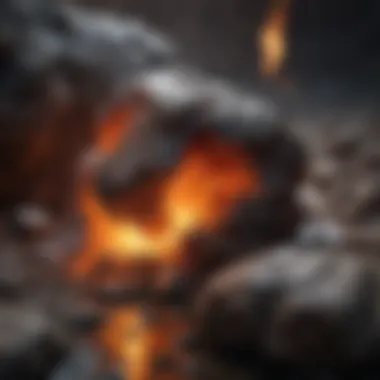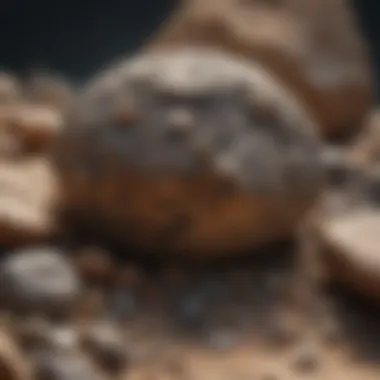Discover the Intriguing Diversity of Rocks in Nature


Rock and Fossil Identification
The intriguing world of rocks encompasses a wide array of types, each with its unique characteristics and significance in the realm of geology. From igneous marvels to the layers of sedimentary rock and the transformational journey of metamorphic specimens, rocks unveil tales of the Earth's evolution and composition with meticulous detail. Enthusiasts delving into the depths of this subject will find themselves immersed in a realm where each stone whispers stories of ancient landscapes and tumultuous processes, waiting to be deciphered. Through keen observation and exploration, these enthusiasts can decipher the intricate language of rocks, unlocking the secrets embedded in their surface and structure. In this section, we delve into the key aspects of rock and fossil identification, shedding light on the types, characteristics, and tools necessary for the discerning collector.
Types of Rocks and Fossils
As we embark on the journey of understanding the world of rocks, we encounter a myriad of classifications that serve as windows into the Earth's past and present. Igneous rocks, born from the fiery cores of volcanoes and magma chambers, showcase a crystalline beauty that reflects their turbulent origins. Sedimentary rocks, on the other hand, reveal stories of ancient seas, rivers, and wind-blown sands meticulously preserved over eons. Lastly, metamorphic rocks carry within them the scars of intense pressure and heat, testifying to the transformative forces that shape the Earth's crust. Fossils, the preserved remains of ancient organisms, add another layer of intrigue to the rock enthusiast's collection, providing glimpses into long-extinct creatures and ecosystems. Understanding these diverse types is essential for any collector seeking to unravel the secrets of the Earth.
Characteristics to Look For
When venturing into the realm of rock and fossil identification, keen observation is key. Each type of rock and fossil boasts distinct characteristics that hint at its formation and history. For igneous rocks, crystal size, texture, and color can reveal valuable information about their cooling process and mineral composition. Sedimentary rocks display layers, fossils, and sediment patterns that speak of ancient environments and depositional settings. Metamorphic rocks bear witness to intense heat and pressure through their foliated structures and mineral realignments. Fossils, ranging from imprint fossils to petrified remains, provide clues about the organisms that once roamed the Earth. By honing their observational skills, collectors can uncover the hidden narratives within each rock and fossil they encounter.
Tools for Identification
Equipped with a curious mind and a discerning eye, rock and fossil collectors can enhance their identification skills with the aid of specialized tools. Hand lenses, magnifying glasses, and microscopes unveil intricate details that escape the naked eye, allowing for closer examination of textures, colors, and mineral grains. Geologists' hammers and chisels become invaluable companions when extracting fossils or breaking open rocks to reveal their internal structures. Field guides and rock atlases offer reference materials to aid in proper classification and identification, enriching the collector's understanding of the vast world of rocks. By utilizing these tools thoughtfully, enthusiasts can navigate the terrain of rock and fossil identification with confidence and precision.
Introduction to Rock Types
In the vast realm of geology, the Introduction to Rock Types sets the stage for an enlightening journey through the intricacies of Earth's composition. This section serves as a gateway to understanding the foundations of rock formations and their profound influence on geological studies. By delving into the classification of rocks into igneous, sedimentary, and metamorphic categories, readers are equipped with a foundational knowledge essential to explore the world of rocks with clarity and purpose. Understanding Rock Types not only aids in recognizing the physical attributes of each rock but also unravels the historical narratives embedded within their structures.
Understanding Igneous Rocks
Formation Process of Igneous Rocks
The Formation Process of Igneous Rocks unveils the remarkable journey of molten material as it solidifies and shapes into diverse rock formations. This pivotal aspect elucidates the cooling process of magma or lava, highlighting the role of crystallization in determining the texture and composition of igneous rocks. By comprehending the intricacies of igneous rock formation, geology enthusiasts can grasp the fundamental principles governing volcanic activity and geological phenomena. The distinctiveness of the Formation Process lies in its ability to capture geological dynamics in a snapshot, providing crucial insights into the Earth's geological activities.
Common Examples of Igneous Rocks
Exploring the Common Examples of Igneous Rocks introduces enthusiasts to a plethora of renowned rock formations like granite, basalt, and pumice. Each exemplar showcases unique characteristics such as mineral composition, color variation, and texture intricacies, offering a tapestry of geological diversity. Understanding these prominent igneous rocks not only enriches one's geological acumen but also fosters a deep appreciation for the monumental forces sculpting the Earth's crust. The significance of studying these examples lies in unraveling the geological heritage encapsulated within their stony structures.
Intriguing Characteristics of Igneous Rocks
Delving into the Intriguing Characteristics of Igneous Rocks unravels a captivating world of geological marvels, from the mesmerizing patterns of intrusive rocks to the glassy sheen of extrusive formations. These characteristics, ranging from grain size variations to color contrasts, encapsulate the dynamic nature of igneous rocks and their geological timestamp. By scrutinizing these unique features, geology aficionados can decipher the environmental conditions under which these rocks solidified, offering a window into past volcanic events and tectonic processes. The allure of Igneous Rocks lies in their ability to preserve ancient narratives within their mineralogical structures, inviting exploration and contemplation.
Insight into Sedimentary Rocks
Deposition and Formation of Sedimentary Rocks


Embarking on the journey of Deposition and Formation of Sedimentary Rocks unveils the stratigraphic timeline of sediment consolidation, shedding light on the gradual layering process leading to rock formation. This foundational aspect underscores the role of erosion, transport, and deposition in shaping sedimentary layers, culminating in the formation of diverse rock types. By exploring the stratigraphic records embedded within sedimentary formations, rock enthusiasts gain insights into past environmental conditions, geographical changes, and paleontological remains. The allure of Sedimentary Rocks lies in their ability to encapsulate fragments of Earth's ancient landscapes within their intricate layers, making them invaluable archives of geological history.
Diverse Varieties of Sedimentary Rocks
The exploration of Diverse Varieties of Sedimentary Rocks introduces enthusiasts to a mosaic of rock types, ranging from sandstone's coarse grains to limestone's organic imprints. Each variant exhibits distinct characteristics such as bedding structures, fossil content, and color schemes, offering a rich tapestry of geological diversity. Understanding the significance of these diverse sedimentary rocks enables geology enthusiasts to decipher past climatic conditions, depositional environments, and tectonic influences shaping Earth's surface. By delving into the unique features of each sedimentary variety, enthusiasts unravel the rich narrative woven within these rock formations, fostering a deeper connection to Earth's geological legacy.
Unique Features of Sedimentary Rocks
Exploring the Unique Features of Sedimentary Rocks unveils a world of geological artifacts brimming with historical anecdotes and ecological nuances. From the ripple marks etched in sandstone to the concretions peppered in shale, each feature whispers tales of ancient waters, wind patterns, and biological remnants. The uniqueness of these sedimentary features lies in their ability to serve as time capsules of Earth's past, capturing moments frozen in stone and offering glimpses into bygone ecosystems. By deciphering the subtle imprints and textures embedded within sedimentary rocks, enthusiasts embark on a journey through Earth's evolutionary epochs, appreciating the intricate tapestry of life and geological processes sculpted within each layer.
Exploring Metamorphic Rocks
Transformation Process of Metamorphic Rocks
Embarking on the Transformation Process of Metamorphic Rocks unveils the geological alchemy behind rock metamorphism, where existing rocks undergo profound changes under intense pressure and heat. This transformative process, characterized by recrystallization and mineral reorganization, imparts distinct textures and structures to metamorphic rocks, reflecting the geological forces at play. By deciphering the metamorphic journey of rocks, geology aficionados gain insights into tectonic events, mountain-building processes, and regional metamorphic gradients. The allure of studying this transformation lies in discerning the resilience and adaptability of rocks under extreme geothermal conditions, offering a window into Earth's dynamic geological history.
Distinctive Types of Metamorphic Rocks
Exploring the Distinctive Types of Metamorphic Rocks leads enthusiasts through a spectrum of rock variants, from the sleek foliations of slate to the glistening layers of marble. Each metamorphic type showcases unique textures, mineral assemblages, and structural features, embodying the geologic history and transformational journeys encoded within their crystalline structures. Recognizing the distinctive characteristics of metamorphic rocks not only deepens one's understanding of geological processes but also unravels the tectonic events and historical narratives shaping Earth's lithosphere. The significance of delving into these metamorphic varieties lies in appreciating the geological resilience and transformational potential manifested in their diversified forms.
Fascinating Aspects of Metamorphic Rocks
Unveiling the Fascinating Aspects of Metamorphic Rocks immerses enthusiasts in a realm of geological wonders, from the dynamic foliations of gneiss to the vibrant banding of schist. These intriguing features, encompassing supernatural textures and mineralogical reactions, offer a glimpse into the metamorphic forces reshaping Earth's lithospheric story. By exploring the captivating aspects of metamorphic rocks, geology enthusiasts unravel the intersections between heat, pressure, mineral metamorphism, and structural deformation, revealing the intricate web of geological processes unfolding beneath Earth's surface. The allure of these metamorphic wonders lies in their ability to showcase the transformative power of geological forces, providing a window into Earth's deep crustal dynamics and metamorphic landscapes.
In-Depth Analysis of Rock Categories
When delving into the meticulous realm of rock categories, it becomes imperative to grasp the intricate nature of these geological formations. An in-depth analysis of rock categories serves as a cornerstone in understanding the Earth's diverse composition and history. By dissecting the characteristics and classifications of igneous, sedimentary, and metamorphic rocks, we unravel the rich tapestry of geological evolution and significance. This section encapsulates the essence of rock studies, offering a comprehensive guide to enthusiasts and scholars alike.
Intricate Details of Igneous Rocks
Classification Based on Texture
Igneous rocks undergo a fascinating journey of formation, leading to a diverse range of textures that provide crucial insights into their history and properties. Classification based on texture delineates these rocks into categories like aphanitic, phaneritic, and glassy, each holding unique characteristics denoting their cooling conditions and mineral composition. Understanding these textures is critical in interpreting the geological processes that shaped these rocks and uncovering their underlying stories.
Composition Variations in Igneous Rocks
The composition of igneous rocks serves as a defining factor in discerning their origins and properties. From silica-rich granites to iron and magnesium-laden basalts, the spectrum of compositions in igneous rocks showcases a myriad of chemical influences and environmental contexts. By exploring these variations, we gain a deeper appreciation for the diverse nature of igneous formations and their role in the geological landscape.


Significance of Igneous Rocks in Geology
Igneous rocks play a pivotal role in the field of geology, acting as windows into the Earth's past and processes. Their formation, mineralogy, and distribution provide crucial data points for understanding tectonic activities, volcanic eruptions, and magma evolution. The significance of igneous rocks in geology extends beyond surface aesthetics, contributing substantially to fundamental research, resource exploration, and geological hazard assessments.
Detailed Examination of Sedimentary Rocks
Layering and Structure of Sedimentary Rocks
Sedimentary rocks exhibit captivating layers and structures that unveil stories of ancient environments and depositional processes. The stratification, bedding, and fossils within these rocks offer valuable clues about past climates, ecosystems, and geological events. By examining the layering and structure of sedimentary rocks, geologists can reconstruqt habitats long gone and decipher the dynamic history of our planet.
Environmental Clues Provided by Sedimentary Rocks
Sedimentary rocks act as archives of environmental conditions, preserving critical clues about past landscapes, climates, and life forms. Through the composition of minerals, fossils, and sediment textures within these rocks, scientists can infer past sea levels, climatic fluctuations, and sediment transportation mechanisms. Unraveling these environmental clues expands our understanding of Earth's dynamic past and the interconnectedness of geological processes.
Role of Sedimentary Rocks in Earth's History
The role of sedimentary rocks in Earth's history is monumental, narrating chapters of continental drift, climate evolution, and biological diversication. These rocks record eras of glaciation, desertification, and marine transgression, imprinting the planet's history in layers of sandstone, shale, and limestone. Understanding the role of sedimentary rocks in Earth's history allows us to piece together the intricate puzzle of geological timelines and environmental transformations.
Comprehensive Look at Metamorphic Rocks
Metamorphic Grade and Its Implications
Metamorphic rocks undergo transformative processes of pressure, temperature, and chemical alteration, leading to varying degrees of metamorphic grade. The intensity of metamorphism determines the recrystallization, foliation, and mineral changes within these rocks, indicating the conditions of their formation and deformation. Analyzing the metamorphic grade provides insights into the tectonic forces, geothermal gradients, and burial depths experienced by these rocks throughout their geological journey.
Formation under Extreme Pressure and Heat
Metamorphic rocks form under extreme conditions of pressure and heat, altering their mineralogy, texture, and structural integrity. The profound effects of metamorphism result in profound changes in rock compositions, creating marbles from limestones or schists from mudstones. The formation under such extreme environments showcases the dynamic and resilient nature of rocks, highlighting their adaptability to Earth's internal processes.
Applications of Metamorphic Rocks in Various Fields
Metamorphic rocks find applications across various industries and scientific disciplines, owing to their unique physical and chemical properties. From providing ornamental stones like marble and slate to serving as indicators of crustal movements through index minerals, metamorphic rocks offer a wealth of utility in construction, art, and geology. Exploring the applications of metamorphic rocks sheds light on their versatility and importance in shaping human societies and understanding Earth's geological dynamics.
Significance of Rock Diversity
Rock diversity plays a crucial role in understanding the Earth's geological history and composition. By exploring the different types of rocks, we unravel the intricate tapestry of our planet's past and present. Igneous, sedimentary, and metamorphic rocks offer valuable insights into various geological processes, from volcanic activity to tectonic shifts. Each rock type holds unique properties that contribute to the overall diversity of our landscapes and ecosystems. Understanding rock diversity enables us to appreciate the complex interactions between different rock formations and their impact on the environment.
Geological Importance of Rock Varieties


Role of Rocks in Unraveling Earth's Evolution
Rocks serve as silent storytellers, preserving the secrets of Earth's evolution over millions of years. The stratigraphic layers in rocks offer a chronological timeline of geological events, helping geologists decipher the planet's history. By studying the fossil record embedded in rocks, scientists can determine past climates, life forms, and even major extinction events. The role of rocks in unraveling Earth's evolution is paramount to reconstructing the dynamic narrative of our planet's journey through time.
Impact of Rocks on Landscape Formation
Utilization of Rocks in Construction and Industry Rock formations are not only geological marvels but also essential resources for construction and industry. The durability and diversity of rocks make them valuable materials for buildings, roads, and infrastructure. From granite foundations to limestone quarries, rocks are integral to modern construction techniques. Moreover, various industries rely on rocks for manufacturing processes, such as using marble in sculpting or extracting metals from ores. The utilization of rocks in construction and industry highlights their versatility and economic significance in our daily lives.
Environmental Impact of Rock Formations
Erosion and Weathering Effects on Rocks
Erosion and weathering shape the Earth's surface by breaking down rocks into sediments and altering landscapes over time. The continuous cycles of erosion, propelled by wind, water, and ice, sculpt intricate landforms like canyons, arches, and valleys. While erosion can create visually stunning features, it also exposes the vulnerability of rock formations to environmental forces. Understanding the effects of erosion and weathering on rocks is crucial for predicting changes in landscapes and mitigating potential hazards.
Ecological Significance of Different Rock Types
Different rock types harbor distinct ecosystems and microclimates that support a diverse array of plant and animal species. Each type of rock contributes to the formation of specific habitats, influencing soil composition, moisture retention, and nutrient availability. The ecological significance of different rock types extends to biodiversity conservation and ecosystem stability. By studying the relationship between rocks and ecology, we gain valuable insights into ecological resilience and the interconnectedness of natural systems.
Challenges Posed by Human Interaction with Rock Environments
The increasing human presence in rock environments poses significant challenges to their preservation and conservation. Activities such as mining, quarrying, and urban development can disrupt natural rock formations and ecosystems, leading to habitat fragmentation and loss of biodiversity. Pollution from industrial processes and improper waste disposal further degrades rock environments, affecting both terrestrial and aquatic ecosystems. Mitigating the challenges posed by human interaction with rock environments requires sustainable land management practices and a conscious effort to balance human needs with environmental conservation.
Cultural and Artistic Value of Rocks
Rocks hold symbolic and artistic value across cultures, reflecting human interpretations of the natural world and our creative expressions. In various traditions and beliefs, rocks symbolize strength, permanence, and spirituality, shaping cultural narratives and practices. Artists draw inspiration from rock formations, integrating their textures, colors, and patterns into visual artworks and sculptures. Rock collecting enthusiasts not only appreciate the geological diversity of rocks but also find solace and connection with the Earth's ancient formations. The cultural and artistic value of rocks transcends mere physicality, embodying a deep-rooted relationship between humans and the geological wonders of our planet.
Conclusion: Appreciating the Diversity of Rocks
When delving into the realm of rocks, one cannot overlook the paramount aspect of appreciating their diversity. The significance of understanding and valuing the vast array of rock types cannot be understated. By recognizing the unique characteristics and geological implications that each rock category presents, individuals can truly grasp the intricacies of the Earth's history and composition. Embracing the diversity of rocks paves the way for a more profound exploration of our planet's geological mysteries, offering a profound connection to the natural world and its ever-evolving landscape. Appreciating the distinct traits and roles of igneous, sedimentary, and metamorphic rocks fosters a holistic perspective on Earth's geological processes, enriching our knowledge and sense of wonder toward the depths of our planet's foundation.
Enduring Fascination with Geological Wonders
Infinite Beauty Found in Rock Varieties
In contemplating the infinite beauty found in the various rock varieties that Earth harbors, one is immediately struck by the mesmerizing diversity and aesthetic allure that these geological formations exhibit. The subtle gradations of color, intricate patterns, and textural contrasts intrinsic to rocks evoke a sense of timeless grandeur and geological artistry. This organic beauty serves as a testament to the magnificent forces at play in the Earth's crust, encapsulating millions of years of geological evolution within their mineral structures. The enduring appeal of rock varieties lies in their ability to captivate the imagination and inspire a deep appreciation for the natural world's unparalleled artistry.
Continued Exploration and Discovery in the World of Rocks
As we venture further into the vast landscape of rocks, the spirit of continued exploration and discovery ignites a fervor for unraveling the Earth's geological tapestry. The ongoing quest to unearth novel rock formations, decipher their intricate compositions, and unveil the stories they hold within their ancient layers propels geological enthusiasts and researchers alike on a perpetual journey of scientific enlightenment. Each expedition into the realms of geology unveils new insights, sparking curiosity, and driving the relentless pursuit of knowledge within this dynamic field. The enduring allure of venturing into the world of rocks lies in the promise of endless discovery and the thrill of unraveling the Earth's geological mysteries.
Encouraging Curiosity and Appreciation for Earth's Geological Marvels
At the core of Earth's geological marvels resides a profound invitation to explore, understand, and appreciate the wonders of our planet's rocky foundations. Encouraging curiosity and fostering an appreciation for the intricate formations that encompass our world's surface cultivates a deep reverence for the forces that have shaped our planet over millennia. By embracing the geological marvels that surround us, we not only gain a richer understanding of Earth's history but also develop a sense of responsibility to preserve and protect these natural treasures for future generations. The act of fostering curiosity and appreciation for Earth's geological wonders serves as a gateway to profound insights, instigating a lifelong journey of discovery and connection with our planet's intricate geological tapestry.







